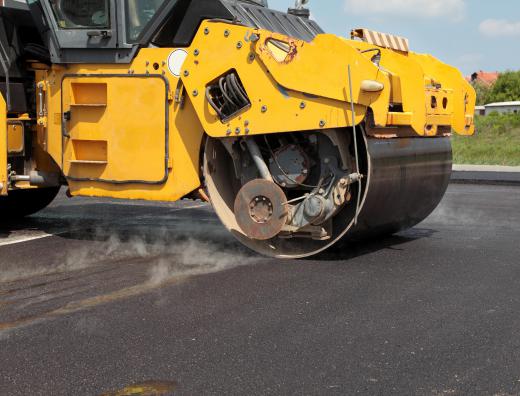A drum compactor is a heavy construction machine that compacts soil, asphalt, or concrete to create a level surface. These machines are manufactured in a variety of forms for specific industries, such as highway construction or landfill compaction. Common forms of drum compactor machines can include a single or double drum, and may be vibrating or static.
One of the most common compactor types uses a single drum. The heavy, cylinder-shaped drum is attached to the front of a machine driven by an operator. This type of drum compactor is generally used for compressing loose soil for road construction or compacting newly poured concrete for a level surface. Sizes of this machine can vary from relatively small, enabling it to work in confined job sites, to extremely large, increasing productivity on a massive construction project.

Double drum compactor machines offer even more compaction power. The machine has a front and rear drum combination to ensure that the surface is densely packed beneath its weight. Job sites with extremely loose soil may use this machine type, but many applications for the double drum involve fine concrete surface compaction of the type used to construct roadways. Extra compaction from the dual drums decreases voids in the wet concrete for a long-lasting road formation.
Most drum compactors have a smooth surface for the best compaction results; however, special applications may require a particular drum shape. A landfill compactor has rounded knobs protruding from the drum so that it can infiltrate the trash surface and eliminate any air pockets below. This specialized compaction helps to create more storage space within the landfill. Depending on the landfill's size, the drum compactor can be single or double drum.
Some compactors have the added option of vibration. Within the drum is an electrically powered vibratory motor that creates pulses of mechanical motion. These pulses apply even more compaction power to a surface compared to basic drum weight driving across the area. Vibration pulses jostle the ground material to force it into open crevices and voids. As a result, the surface is more uniform, preventing future warping or cracking of the constructed surface.
On the other hand, some construction sites only use static drum compactor types, especially if the surrounding area is densely populated. Large vibrations may disturb those living in the immediate area if a vibratory drum is used. Static compactors can be constructed with heavy metal drums that use simple gravity and weight for an effective compaction. The drum is often removable to allow lighter or heavier cylinders to be attached for various applications.
